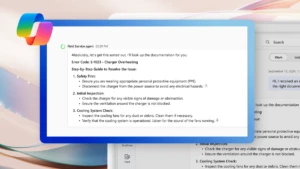
Forrester TEI highlights 3 benefits of Power Platform premium capabilities
Microsoft Power Platform recently commissioned a Forrester Total Economic Impact study to help customers better understand the value of Microsoft Power Platform premium capabilities. This study expounds on how premium capabilities empower enterprises to unlock more business value using the platform.
The study accomplishes this by highlighting three key benefits of premium Microsoft Power Platform. The first is demonstrating greater scalability of low-code solutions across an enterprise. Second is the removal of barriers from citizen development for increased low-code impact, while maintaining enterprise-grade security. Third is the reduction of traditional development costs and maintenance of legacy applications.
By surveying 33 current Microsoft Power Platform customers and conducting in-depth interviews with four customers, Forrester was able to generate a composite organization that is designed to be representative of the average Microsoft Power Platform customer using premium capabilities. The composite organization is designed to mimic a global enterprise that brings in annual revenue of USD 3 billion and has 10,000 employees.
Via the three highlighted benefits, the composite organization, or in other words, the average customer, netted an additional 140 percent ROI with premium capabilities, on top of the 502 percent ROI customers earn from out-of-box Microsoft Power Platform, a 45 percent reduction in application development costs, and a net present value (NPV) of USD 8.32 million over three years.

1. Greater scalability of low-code solutions across an enterprise
Greater scalability of low-code solutions across an organization contributes to these figures due to premium capabilities making it possible to deconstruct data siloes, increase reusable code, and scale governance and security practices. For example, with premium Microsoft Power Platform, organizations gain access to Microsoft Dataverse, outside of Microsoft Teams, a product designed to make data management and stewardship easier.
Dataverse helps customers integrate their disparate data from various sources and make their data cleaner. In turn, that data and the subsequent code become increasingly reusable across the organization for even greater scalability. Prior to Dataverse, companies could either devote substantial development resources to building a solution or rely on SharePoint or other ad hoc workarounds that were inconvenient for large-scale or complex data models.
In fact, after implementing Dataverse in their low-code practice, the head of Microsoft Power Platform at a transportation company shared that their reused code created increased efficiencies. They said: “The Dataverse gives us a lot more possibilities for duplicating applications. People will approach someone who has already made an application. The person will package it and give it to him. He readapts it and reuses it almost identically.”
2. Removal of barriers from citizen development for increased low-code impact
The second benefit of removing barriers from citizen development, which makes it easier for citizen developers to build impactful solutions and adopt low-code tools, contributes to streamlined business processes and improved business outcomes. Without premium Microsoft Power Platform capabilities, some organizations were unable to expose their data safely and efficiently. This inhibited application development velocity and kept many necessary solutions left in the IT backlog. However, when customers moved to premium capabilities, they could use Dataverse, premium data connectors, and Managed Environments to unblock their citizen developers.
Managed Environments and the center of excellence starter kit enables IT departments to implement easily scalable enterprise grade governance and security to ensure compliance across their organizations. With that solid foundation set, citizen developers are able to use integrated data in Dataverse for solutions that were previously inhibited by data siloes. Lastly, premium connectors provide citizen developers access to key databases such as SAP and to use custom APIs built by professional developers to reduce application backlogs.
The streamlined business processes that result from unblocking citizen developers have a present value of USD 7 million over three years and the improved business outcomes that follow have a present value of USD 3 million over three years. These citizen developer outcomes aren’t easy to come by as a solution architect at a financial services company said: “[Microsoft Power Platform has] increased the amount of citizen developers [by making] low-code [and] no-code platforms widely available. So, today, we have [many] active makers who are creating apps and flows. Most of them would not have any other way to create those systems if it wasn’t for the Power Platform.”
3. Reduction of traditional development costs and maintenance of legacy applications
The third benefit of premium Microsoft Power Platform capabilities is the increased reduction of traditional application development costs and maintenance of legacy applications. One of the key benefits of low-code technology is the ability to expedite legacy application retirement and further digitize your organization. This is due to the innate ability of low-code to do more with less, as organizations don’t need to spend nearly as many people hours or capital on building net-new solutions and find it more cost efficient to retire legacy applications.
This innate ability is only strengthened when governance and security are made easier with Managed Environments, data siloes are torn down with Dataverse, and premium connectors make it easier than ever to reuse APIs for a multitude of solutions. Due to these premium capabilities, an average of 54 percent of legacy applications were retired.
The savings generated from retired legacy applications were valued at USD 496.8 thousand, and eliminated traditional development efforts were valued at USD 3.8 million over a three-year period. Learn the three key steps Microsoft recommends for organizations to take to earn these benefits in the Low-code signals 2023 report.
Microsoft Power Platform
Learn more about the potential benefits your organization can garner from premium Microsoft Power Platform capabilities.





